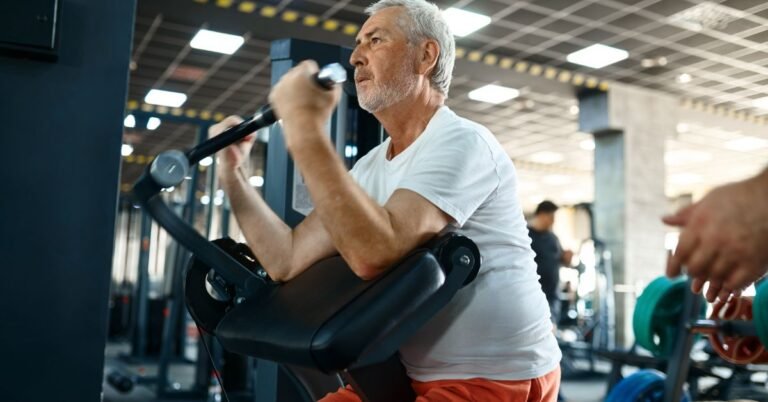Muscular strength and power are often used interchangeably but there is an important distinction between the two. Somebody who is exceptionally strong may not be very powerful if they can’t contract their muscles quickly.
As we will explore in detail in this article, the main difference between muscular strength and power is speed. We’ll also discuss why strength and power are important aspects of fitness for all ages, especially so for older adults.
What we’ll cover:
Speed Plus Strength Equals Power
Muscle strength is the maximum amount of force you can generate in a specific movement, at a specific velocity. This is usually measured as 1 rep max in the gym (the maximum amount of weight you could lift or perform with a certain movement), or there are special machines which measure how much force you can exert against them.
Muscle power is slightly different. It takes into account the speed of the contraction as well: it is the product of contraction and velocity. So muscle power is about the production of force quickly. It is an extremely important factor to consider in the training of any individual.
To put it simply, the difference between muscular strength and muscular power is speed. Power is the measure of speed plus strength.
Why is it important to measure strength vs power?
Sometimes we have to react quickly, or perform a task quickly. Most injuries occur suddenly. In order to save ourselves from a trip or a fall we need our muscles to react and contract quickly.
It is an aspect of exercise prescription that is often forgotten, especially in adults and older adults. Even in individuals who practice strength training as they get older. If the focus is always on slow controlled repetitions in our training, we are never training muscle power and we will never improve the ability of our muscles to perform a quick contraction.
The loss of muscle strength and its relationship with a decline in functioning, independence and quality of life have been well established as we age. The loss of muscle power is rarely considered. Although the evidence actually tells us that muscle power declines sooner and more rapidly than muscle strength (1).
Some studies even suggest that peak muscle power is actually a better determinant of functional status and independence in older populations (2). Physiologically this loss is due to reduced muscle mass, quality, composition, individual muscle fiber contractile properties (loss of number and size of fast type II muscle fibers) and changes in neuromuscular functioning (1).
Measuring muscle power is a bit more difficult than measuring muscle strength. In the research these include methods such as measuring vertical jump height and the use of special equipment to measure power of the lower limb muscles. Other ways to measure power include more functional tasks, such as time to rise from a chair (5 or 10 times) or time to climb a flight of stairs.
These tasks are easier to perform among older adults and have a greater functional carry over to our everyday tasks. A really interesting recent study showed that a simple timed 5-repetition sit-to-stand power test was better related to functionalities and performance measures of older adults than traditional methods of measuring sarcopenia and loss of muscle strength (3).
How can we train, maintain or improve muscle power?
Traditionally it was thought plyometrics/jump training type activities were required to improve muscle power. Which indeed, they have been shown to. However, increasing evidence is showing that heavy resistance training can actually improve power measurements to the same or a greater extent (4).
This is because a key component of muscle power is to have the muscle strength in the first place, to even be able to consider asking that muscle to perform a task quickly. Heavy strength training alone has been shown to improve power measurements, especially in the lower limb.
However if you want to be more specific in training muscle power the vital component is to perform some of these movements quickly (at a higher velocity). Particularly the concentric (muscle shortening) part of the movement. Lets give you a few examples of this in practice:
- Stand quickly from the squat or the chair in your squat or chair stand exercise
- Push your dumbbell weights up quickly in a chest press or shoulder press exercise
- Lift the dumbbells or weights quickly from the floor in a deadlift exercise
- Rise on our toes quickly in a heel raise exercise
These are really easy ways to add in muscle power training into your normal strength/resistance training exercises. Numerous studies have demonstrated that exercise interventions with muscle power targets are well tolerated, safe and effective in older adults (2).
The extent to which specific muscle power training is required in an exercise programme depends on the goals of the individual. It may be sufficient to focus mostly on heavy resistance training, adding in 1 session a week with some exercises focusing on performing the concentric (muscle shortening) part of the movement quickly (i.e. the examples above).
If an individual’s goals are more focused on power and the ability to perform movements and tasks quickly (e.g for a sporting activity), more specific power focus may be required. Such as ensuring the resistance/load of the exercises is sufficient. Studies show benefits from incorporating high velocity resistance training with high loads/resistances of approximately 70% of 1RM (1 rep max), for training interventions of at least 12 weeks.
Ultimately muscle power is an often neglected part of an exercise programme, especially in older adults. Perhaps we have traditionally been too cautious with trying to incorporate power training exercises for these populations, and perhaps older adults have not been educated enough on the relevance of muscle power to our everyday lives.
But when we consider how often we have to react or perform a task quickly – to prevent an injury, fall or simply get up out of a chair or climb the stairs – it is clear how essential the ability of our muscles to contract quickly is. Additionally, as we have explored in this article, numerous studies have demonstrated a link between muscle power and our functioning and independence as we age. These are key factors for being able to live a happy and free life into old age.
It therefore seems clear that we should all start to put a little bit more focus on muscle power in our exercise programmes. Why not get started this week with incorporating some higher speed movements into your resistance training exercises? Get in touch on social media or leave a comment below to let us know how it goes!




